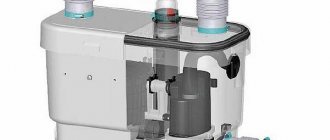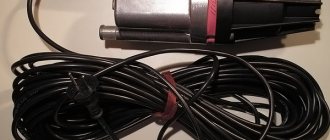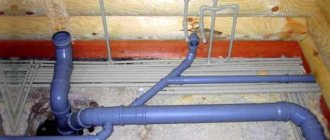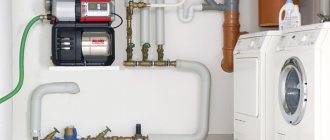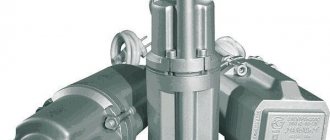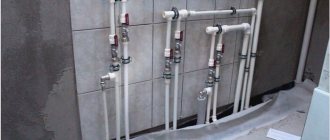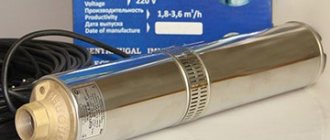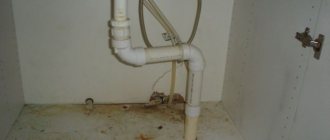Device and purpose
A pump with a grinder is a surface sewer pumping installation that allows you to organize the removal of wastewater where it is not possible to do this using a gravity system. This is a small plastic container with a powerful built-in pump that pumps waste into the sewer. The movement of drains can be both vertical and horizontal. There are installations with a grinder that can be connected to toilets, and there are those without a grinder - for “gray” waste from sinks, showers, bidets, etc.
The sewer pump for toilets and other plumbing fixtures is small in size
Application area
A sewer pump is used in cases where it is impossible to create a gravity sewer system. In most cases, when a plumbing fixture, washing machine or dishwasher is installed below the entrance to the sewer. This is why forced sewage pumps were invented. This solution allows you to move bathrooms and technical rooms to basements or semi-basements.
You can connect sanitary pumps in the bathroom, toilet, kitchen, and laundry room. In any room where water drainage is required and the sewer drain is far away
A pump with a grinder is also installed if it is decided to build a bathroom after the renovation is completed and the sewerage system is not connected to the place where the plumbing is supposed to be installed. In this case, the installed equipment is connected to a compact sewage pump, and it is connected to the sewer. What is the difference? In the following:
- the diameter of the outlet pipes for the sewer pump is much smaller than for the gravity system (28-40 mm);
- drains can rise up to a height of up to 9 meters;
- horizontal wastewater disposal is possible up to 100 meters (requires a minimum slope of 1-4%).
All this allows you to organize a connection to an existing sewer system almost anywhere at minimal cost.
Design and principle of operation
The sewage pump consists of a plastic storage container and a pump. Some models that can be connected to a toilet have a grinder. The filling level is controlled by a sensor. When it is triggered, the grinder and pump are turned on, and wastewater is pumped into the sewer system. The shutdown is controlled by a second sensor - it turns off the power when the wastewater level drops below a certain level. This is a simplified algorithm for the operation of pressure sewerage.
Sewage pump with grinder: device
There are sewage pumping stations designed to connect devices of various types and quantities. The simplest one is designed to connect one or two devices, the most productive one has three additional pipes (and one main one). Accordingly, the container has one or more inlet holes (depending on the model) and one outlet hole. Pipes coming from the plumbing are connected to the inlets, and the outlet is connected to the sewer.
For pumping out high-temperature wastewater from washing machines, dishwashers, and bathtubs, there are special models made of heat-resistant materials. A conventional sewage pump cannot cope with such a load. Therefore, to connect such equipment you need to look for certain models.
Installation instructions
When installing a pump for a sink in the kitchen, it is necessary to take into account that water at a temperature of up to 90°C can be discharged into it, so it is only allowed to use plastic pipes designed for such degrees. Corrugated pipes are prohibited.
General connection conditions:
- The device can be installed in any convenient place.
- The pipe from the liquid source must be laid with a slope of at least 2-3 mm per meter. Lack of slope will impair the performance of the system.
- It is prohibited to combine drains from several devices, as there is a risk of overflow. If several pumps are used, then each is connected to the main riser separately.
- If the length of the outlet pipe located below the inlet pipe is more than 2.5 m, it is equipped with an air valve.
- To power the equipment, it is necessary to use a separate line from the panel, which must be equipped with a circuit breaker and a residual current device.
Advantages and disadvantages
The main advantage of compact individual sewerage installations is that they allow you to equip a sewerage system without carrying out large-scale construction or repair work. With their help, complex problems are solved:
- Drainage arrangement when plumbing fixtures are located below the entry point into the sewer system.
- Equipping a bathroom without carrying out large-scale civil works.
Another positive point is the use of small diameter pipes. Most toilet pumps are connected to the sewer using plastic pipes with a diameter of 28 mm - 32 mm - 40 mm. Only high-capacity installations require the installation of 50 mm pipes. Such plumbing networks are easier to hide. Even if it was not possible to hide them, they do not attract as much attention as the standard one hundred millimeter ones.
Examples of sewage pumps for toilets and bathrooms
However, there are also disadvantages:
- Dependence on electricity. No power - sewerage doesn't work. A redundant source is required for uninterrupted operation.
- The pumps are noisy. Manufacturers are improving their products, installing pumps with lower noise levels, but they are still present.
- Compliance with certain operating rules is required. For example, it is undesirable for fibrous materials to enter the shredder. Modern shredders cope well with toilet paper, but with fibrous components and hair they are a problem. They wrap around the screw, reducing the quality of chopping. Sooner or later the screw gets blocked. An installed overheat sensor will not allow the equipment to burn out - it will turn it off earlier. But the installation will have to be disassembled and cleaned, and this is not the most pleasant task.
There are compact models for installation in niches
Well, the main drawback is that the pumps burn out. If the power and performance are selected correctly, unsuitable objects do not fall into the sewer, and they can work for years. But if there is a selection error, when the equipment is operated to the limit, the pumps often fail. Therefore, when choosing a sewer pump for a toilet, it is better to choose one with a margin of performance. It will cost more, but this installation will last longer.
Classification and types
There is no single classification of forced sewer installations, but they can be divided according to several parameters:
- Presence of a chopper. It is needed if the sewer pump is connected to the toilet.
- Performance. This is the volume of wastewater that can be pumped per unit time. There are installations with low productivity and even very solid ones. The choice depends on the number and type of connected devices.
- The temperature of the pumped medium is from 40°C to 90°C. Everything is clear here - drains from a dishwasher, washing machine, and bathtubs require sewer pumping stations capable of pumping wastewater at high temperatures.
- Duration of work. There are installations that can only be turned on for a short time (they are installed on one or two devices), and there are more “long-lasting” ones (can be used to drain the wastewater of an entire house). This is usually indicated in the specifications as the duration of operation. The percentage may be 50%. This means that the installation works for 30 seconds and rests for 30 seconds. The operation/cooling interval can be specified in seconds or minutes.
Sewage pump for shower - with installation under the tray
When choosing a pump for forced sewerage, it is worth remembering that they are not designed to connect a bathtub. Bathrooms contain too much water, pumping out which will cause the pump to overheat and block. As a result, it will take a long time to drain the water from the bathroom. There are only a few models of forced sewerage that will cope with this task - SFA Saniplus Silence and Sololift C3. These sewer pumps do a great job of discharging large amounts of warm water.
Other companies propose to make an intermediate pit for forced pumping of drainage from the bathroom into which to drain the water. From it, pump it into the sewer using any suitable device. Taking into account the fact that the pit must be below the drainage level, this method is not always acceptable. And, despite the high cost of SFA Saniplus Silence and Sololift C3, it is often more profitable to install it than to carry out a huge amount of excavation work.
To prevent the tank from overfilling there is an additional alarm device. In some companies it simply beeps when the container is full, in others it also turns off the device connected through it (washing machine or dishwasher).
Installation and connection rules
The installation and connection of toilet pumps and forced drainage from different manufacturers follows very similar rules. But before installation, you should read the instructions for a specific product - there may be special features.
A sewer pump can be installed in the kitchen to remove waste from the sink and/or dishwasher.
Connection
The installation location must be chosen in such a way that the pump can be reached. It does not require special maintenance, but there is a need for cleaning from time to time. If a dishwasher and washing machine are connected to the pump, it is better to regularly check whether the sewage system is clogged with grease, dirt, and salt deposits. If necessary, cleaning with mild detergents is possible. It is better not to use aggressive chemical compounds, as they can damage the plastic and rubber parts of the installation.
If the sewer inlet is higher than necessary
So here are the general rules:
- An individual sewer installation must be grounded. Therefore, the outlet must be three-wire with a working ground. (We read about the installation of a ground loop in a private house here).
- For safety, there must be a circuit breaker and an RCD on the power supply line.
- During installation, the block is fixed to the floor. To reduce the noise level, it is advisable to install it on a vibration-damping base (rubber gasket). It is not advisable to press the housing against the wall so as not to transmit vibration from the pump. These measures are needed to reduce noise levels.
A sewer pump can be installed in the kitchen to remove waste from the sink and/or dishwasher.
- The exhaust pipeline is made of rigid plumbing pipes. There are two recommended options - plastic sewer pipes and copper pipes. Fittings are recommended to be rigid and one-piece.
- Pipelines must be fixedly fixed (to walls, floor, etc.).
In general, installing and connecting a sewer pump for a kitchen or toilet is not a very difficult undertaking. But provided that you already have some idea about working with plumbing. In this case, you can do everything yourself.
Features of the outlet pipeline
Compact plumbing pumps for the toilet can pump wastewater not only vertically, but can also lift it upward. If there is a vertical section in its lower part, it is advisable to provide for the possibility of draining - if you have to clear the pipeline from a blockage, it is better if the drains are drained in a certain place and do not start pouring out during work.
The height of the vertical section of the outlet pipeline is determined taking into account the minimum slope of the horizontal section. Each manufacturer (sometimes each model) has its own minimum slope, but in most cases it is 1-4% (1-4 cm per 1 meter).
Rules for installing a sewage pump
Be careful. The description of sewage pumps indicates the maximum lifting height of wastewater and the maximum horizontal transportation distance. For example: 8 m up, and 80 m horizontally. But this does not mean that by lifting the pipe 4 meters up, it will be possible to transport another 80 meters horizontally. In this case - after a four-meter rise - the length of the horizontal section will be no more than 40 meters. Simply lifting 1 meter upward “takes away” about 10 meters of horizontal transportation. This is important and worth remembering.
Why do you need a sewer pump?
We often have to answer the question: “What are sewerage installations used for?”
In short, the need for such equipment arises when the wastewater does not flow away by gravity. As an example, let's look at three cases.
Moving your kitchen or laundry room to another location
Such redevelopment is carried out in order to convert the kitchen into additional living or working space. Let us say right away that such redevelopment in the apartment requires obtaining a special permit from the BTI, without which work cannot begin.
